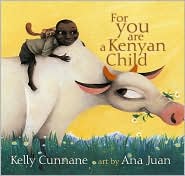
 For You Are a Kenyan Child
For You Are a Kenyan Child by Kelly Cunnane, art by Ana Juan, 2006, Atheneum Books for Young Readers, ISBN 978-0-689-86194-9
PS: From rooster crow to bedtime, a Kenyan boy plays and visits neighbors all through his village, even though he is supposed to be watching his grandfather's cows.
"Hodi? Karibu!" Information in the front of the book tells us that this is the traditional Swahili greeting upon entering another's home, similar to "Anybody home?", answered by "Welcome!". Several more Swahili terms or phrases are given, and are used throughout the book. For a read-aloud, practice these ahead of time! It's an entertaining way of following the boy through a day in his life. We are frequently reminded of his duty to the cows, and I was a little disappointed that he didn't suffer any consequences for neglecting his grandfather and the cows, but this could be discussed with the children as you read the book. Students could compare their daily life with that of the young boy in this story, for instance, when he sees and animal's tail outside the window. We would probably see a squirrel or chipmunk, but he sees a monkey! Good for grades 1-3. Other vocabulary possibilities (English!): maize, eucalyptus (trees), pasture, graze, etc.
On a more serious note, the following book might be good for older elementary students:
Brothers in Hope: The Story of the Lost Boys of Sudan by Mary Williams, illustrated by R. Gregory Christie, winner: Coretta Scott King Honor Award, 2005, Lee and Low Books, ISBN 978-1-58430-232-2
PS: 8-year-old Garang, orphaned by a civil war in Sudan, finds inner strength to help lead other boys as they trek thousands of miles seeking safety in Ethiopia, then Kenya, and finally in the United States.
Written by Mary Williams, founder of The Lost Boys Foundation, this book is based on a true story, as told to her "by the boys who lived it."
The boys find themselves fleeing the war, and realize they must "work together if [they] are to survive." They travel, on foot, the many miles to Ethiopia, then on to Kenya. More than 3800 were eventually relocated into the United States. A story of determination and bravery, and the dream of bringing peace to a long-warring homeland. A movie was even made about the boys. Info
here.




















